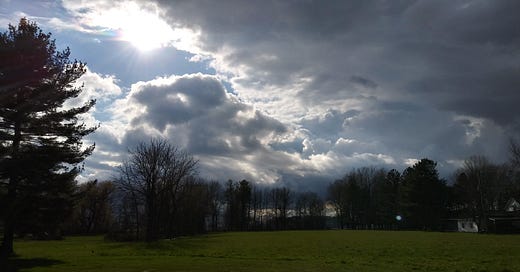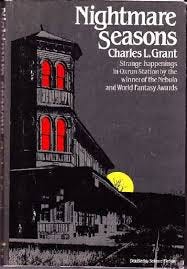Readers unfamiliar with Nightmare Seasons may prefer to read these notes only after reading the collection.
But we are born for lateness.
Time, the body, are our slow vehicles, our chariots without wheels. Look, I’ve just this instant ‘seen’ a book – now I’m going to need two years and two hundred pages in order to recount it with my hands, with my staggering feet, and my breath harnessed to my chest, and from forward to backward and inversely.
This is why we desire so often to die, when we write, in order to see everything in a flash, and at least once shatter the spine of time with only one pencil stroke. And with only one word draw God.
Hélène Cixous (1993)
Nightmare Seasons (1982) was the first thematic collection of four novellas Charles L. Grant created about Oxrun Station, Connecticut. He organized the book around four seasons and four different decades.
Prologue
Both prologue and epilogue are written in first person. At the end of the book, the epilogue is signed: “Charles L. Grant Oxrun Station 1981.”
In the prologue, our narrator is at the Oxrun Station Public Library looking for a friendly writing project to distract him from the one that he has to complete under contract. Librarian Nat gives him a book to take home. Her own copy, not a library volume. That night he begins reading and realizes the book is filled with odd stories about Oxrun Station, each keyed to a season. Hence, Nightmare Seasons is a book within a book.
Part 1 Spring, 1940 “Thou Need Not Fear My Kisses, Love”
The house was confining, squeezing, because there was no work there to challenge her, not the kind of work she enjoyed, not the dealing or the probing or the ferreting of financial hints that would reinstate in her clients a faith in the system. Oxrun had not been severely affected by the Depression; those who had their wealth to hand had not been foolish enough to plunge into the market as deeply as those who had had much more to lose—and did. Even the Station’s middle class had had more sense. Oxrun, as always, took care of its own.
Protagonist Samantha England has plenty to fear from men's attention, though at first she is ignorant of the fact. She has power and intelligence and thinks she can gracefully navigate the office she manages. Until they start dying horribly.
Charles L. Grant is excellent at juggling the half-dozen office characters within a very limited narrative space of the novella.
Three men die before Samantha's nemesis is revealed. When this happens, the moment is shocking and leans toward the ludicrous. But then, after what the reader assumes is the tale's climax and falling action, we get the real punchline climax, and it is clear the real explanation - such as it is - is more horrible than we imagined; more horrible than we can imagine. And, even more hysterically, bent toward the ludicrous.
Part 2 Summer 1950 “Now There Comes a Darker Day”
With hands in my pockets, then, I strolled around the corner of the building, thinking that I was probably just as ridiculous a figure as my friend. I kicked at a pebble, a stone . . . and stopped, lifting my head as if someone had called me. Paul can deride my former profession all he wants, but something halted me then. Yet, when I turned around suddenly and stared at the wall of woodland on the other side of the road, there was nothing. No sound, no movement, not a hint of anything wrong.
I looked back at the cottage, at the porch light, at my bedroom window above.
I looked at the Cock’s Crow.
And without knowing why—and hating myself for it—I wished aloud Grace had stayed with me, and Elizabeth Corey was dead.
“Now There Comes a Darker Day” is a noir horror tale filled with sweltering heat, sudden thunderstorms, and murderous lightning. It features men lured to their doom, and a mystery behind it all that only reveals itself as a mystery when the carnage has to stop.
The narrator is Thomas Gaines Hancock. He is a retired cop who now runs the Cox Crow roadhouse. His narrative tone is Philip Marlowe – we never sense he is writing out this narrative story in hindsight – especially after we read the last few lines. So perhaps it is some kind of posthumous narrative telepathy?
This is a story of carefully observed sociological weird menace, and Grant excels at it.
It might also be read as a“judgment of the lord” on Oxrun Station – carried out by two mute angels or demons? – come to town in disguise. They are not looking for the righteous or the damned – just the lonely who are glad to surrender.
Part 3 Autumn 1960 “Night's Swift Dragons”
“What do you mean by that?”
Jack ignored him. “The trouble was, like all the rest of them sooner or later, I wanted something more. Oh, it was fun—”
“Fun?”
“—figuring out ways to do things to people. One time I remember putting a whole office building under. One at a time. Damn, but the night lasted long that day! One at a time, and everyone of them different. I’ll tell you one thing, Pat: it took a lot of imagination.”
Patrick gestured at him in revulsion and disgust. “I don’t know what you’re talking about. Is this some kind of drug you’re talking about? How can you hold a whole office building without someone getting out?” But he turned away without waiting for an answer.
Karen . . . screaming.
Of course it could be done, he told himself as if he were lecturing to a stupid child. If they can keep five of us penned in here like sheep to the slaughter, why not fifty? Why not five hundred? Because, he thought as that last figure flashed, there had to be a limit to what they could do or they would take hold of a country and not bother with a village.
“Night's Swift Dragons” is the strongest novella in this collection. It begins with Oxrun Station postmaster Patrick Jameson savoring a glorious October evening as he waits for his carriers to return from their appointed rounds. Grant takes his time in the story's opening pages: descriptions of seasonal weather alternating with Jameson's owned interior reveries: tells himself, in what must be a daily mantra, that he has not wasted his life of “not taking part.” He simply prefers not to.
That ease with his own renunciations quickly changes when Jameson's postal carriers return from their routes. About to lock up for the night, they find themselves besieged by the sudden thunderous arrival of a motorcycle gang.
Charles L. Grant is the last writer we look to for a modern-dress update of Howard Hawks’ 1959 masterpiece “Rio Bravo.” But here we are. Panic and courage under siege; infighting, division, unity, fear, and cowardice; beheading, strangulation, exsanguination: with economy, Grant unloads hours of turmoil and dusk-to-dawn action on his six fully rounded characters.
Each character gets their chance to face the cycle gang and its barbaric arsenal. When postmaster Jameson learns the gang's history, his own showdown turns out very different from the grisly fates of his employees.
Part 4 Winter 1970 “The Color of Joy”
Melissa Redmond stood at the window and looked down at the yard. There were ghosts there, shaded by the cherry trees and frightened by the soft noise that slipped out of the house and over the dead grass. She saw them clearly, and as she watched she brought her glass to one cheek and held it there. For the cold that penetrated, and for the reminder that the ghosts were too long in their fading.
“The Color of Joy” begins at a Christmas party. Biology Professor Melissa Redman has returned to her childhood home, and is surrounded by friends and colleagues. Her mother was one of the postal employees who died at the 1960 massacre depicted in “Night's Swift Dragons.” Both her brothers died during the Vietnam war era.
Though she does not at first know it, Melissa has an ally in Oxrun Station. First mistaken for a shadow across the street at night, then seen vanishing around the corner of her garage when she returns home from campus, Melissa's friends chalk up her reports to a nervous breakdown.
Or is it a tulpa? A guardian angel or devil? A demon lover waiting?
Whatever the identity, this figure will not stand idly by when Melissa has been thwarted or made unhappy. Too bad for those who make her so.
Epilogue
Our first person narrator “Charles L. Grant” returns.
He knows the book he has just finished cannot be true. But he cannot dismiss its obvious knowledge of events that explain so many local oddities.
Have we been reading the book Nat gave him in the library in the prologue? Or are these actual events he has checked the book's chapters against? And what are we to make of part two, written in the first person? This seems to require a third explanation for the narrative we have received.
* * *
Nightmare Seasons is an engrossing look at forty years of Oxrun Station history. Grant's ekphrastic skills confidently depict interiors and exteriors of another age. Like water colors by Edward Hopper or Andrew Wyeth, his style does not falsify with prettiness. His fidelity to the region, as a realist and a poet of macabre intrusions, is too hard-won for that.
Jay
15 April 2024




